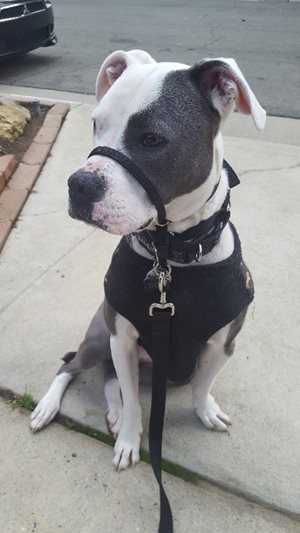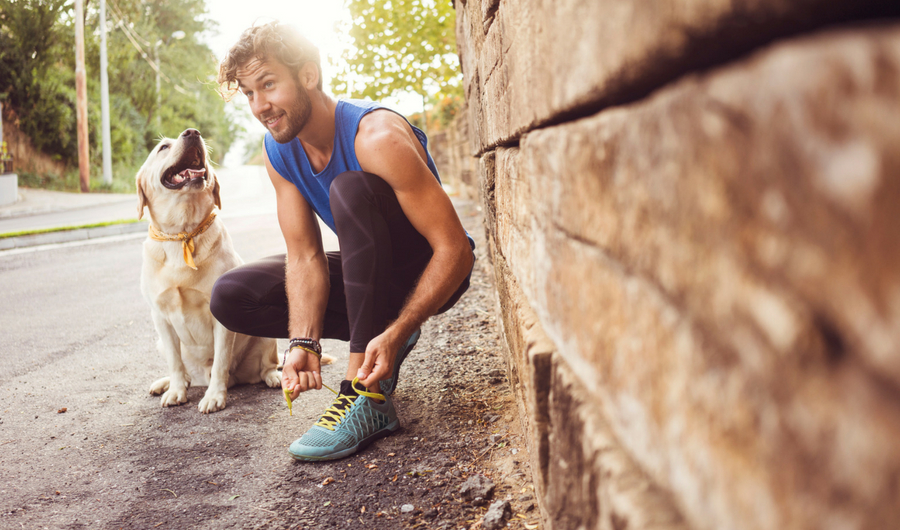Have you ever been frustrated with a workout partner? Maybe they are consistently late meeting you for a workout or have a history of not showing up at all. Or maybe they are good about meeting up for a good quality sweat sesh, but are constantly complaining about the workout and are ruining your positive vibe.

If you like running for cardio, the perfect running partner might be living under your roof already! About 44% of US households include a K9 in their family, which means many of you have a ready-and-willing running partner.
Think about it, Rover is always excited to spend time with you and probably has boundless energy to burn. I have yet to meet a dog who doesn’t love taking a walk with its owner. In fact, my dog Doc starts to get excited if I just put my hand on the drawer his leash is in – his uncontrolled booty wiggle gives away how he feels about going out to explore every time.
Things to Consider Before Taking Your Pooch on a Run
Take into account all of the factors, but the safest option is to consult with your dog’s vet and share your intended plan for running with your dog. Your pet may be dealing with a preexisting condition you are not aware of.
The breed of your dog
Obviously, not all dog breeds are built for running. Basset Hounds, Pugs, English Bulldogs, and Dachshunds are the first to come to my mind. Think about leg length to body size ratio here as well as air intake systems.
Short legs make it hard to keep up with you. Those cute smooshed-in brachycephalic faces can lead to respiratory distress during exercise and high temps due to partially obstructed airways and small nostrils.
Although these pups would love to go for a walk with you, running might not be the best for them.
The age of your dog
It is best to wait until your fur baby is old enough that their growth plates have closed before taking them out on a proper run. Generally, this takes place at about 9 months for smaller dogs and up to 16 months for large dogs.
If you have an older dog, make sure their body can handle the activity. Dogs deal with the same sort of age-related issues we deal with as we age: arthritis, joint issues, etc.
The activity level of your dog
Think about your dog’s current activity level. How easy would it be for someone to roll off of the couch after spending the last 10 years eating bon bons in front of the TV and run a few miles? Should I call 9-1-1 now? The same goes for your four-legged companion. Doing too much too soon will increase your dog’s chance of injury.
The training level of your dog
If your dog doesn’t know its basic commands and struggles with walking on a leash, going for a run with your dog might be a pretty frustrating experience for both of you.
Here are just a few of the issues that you may run into:
-
If your dog darts back and forth or stops to sniff suddenly in front of you, you could easily trip and hurt both of you
-
If your dog constantly pulls on the leash, you may have extra strain put on your shoulder and your running stride might not be natural
-
If your dog doesn’t know the commands ‘sit’ and ‘stay,’ stopping at traffic lights may be dangerous

Choose the right running gear
Use a 3-6 foot leash and train them to stay next to you where you can easily control them no matter the situation.A retractable leash provides too much distance and little to no control over your pet.
For longer running distances, you might consider a harness designed for running to eliminate hot spots and chafing for your little run buddy.
I admit I had issues with my boy Doc pulling hard on the leash. Thanks to a suggestion from one of my personal training clients, a “gentle leader” harness broke him of pulling on the leash in a matter of two weeks.
To be honest, most of that time was spent slowly getting him used to wearing the harness and identifying it with going for a walk. The first time I actually used it on a walk, he pulled two times and that was it. There has been slack in the leash ever since!
Start Slow
You are dealing with an animal, who in the wild had to hunt, stalk, and run for miles to eat and survive off of the land – making them a natural born athlete and running machine. However, your domesticated K9 is a far cry from its fox, coyote, or wolf cousins and it survives by eating from a bowl they didn't have to catch and kill. Most dogs after centuries of breeding are not built to roam and scavenge the countryside for miles at a time.
Go a little further each day
Your domesticated dog needs to progress gradually into running, much the same way you would if you are new to running. Take a few minutes to search for and download a basic free “Couch to 5k” app to your cell phone. These run programs usually take 12-14 weeks to complete with nice gradual distance progression along the way. The programs include run/walk intervals to give you and Fido some active recovery intervals to catch your breath.
Ready, set, warm up…
Just like you, it is best if you let your dog warm up a bit before opening up the throttle as soon as you hit the end of your driveway. Not only will your dog benefit from the same physiological benefits of warming up as you will but it is also a good chance to let him sniff around a bit and hopefully do his business.
I know I would rather my dog hit pause (pun intended) during the warm-up portion of a run to go number two than to interrupt a good tempo run half way through.
Read Your Dog
Being that you don’t speak dog, you will need to pay attention to your running buddy and watch for signs that indicate they might be struggling. These include:
-
Excessive panting
-
Extreme thirst
-
Lagging behind
-
Refusing to move
-
Vomiting
-
Limping
-
Pale mouth mucosa
-
Missing commands they know well
Remember, just like you, your dog can get sore muscles after exercise and might need to take a rest day between runs.
Think About Logistics
Need I mention the need for a poop plan? No one wants to be the rude guy who ignores it and walks away. Have what you need on hand to properly dispose of your mutt's landmine. And no, throwing a loaded bag in the bushes along a public use bike path/running trail does NOT count!
Beyond the potty break, there are some other logistics you need to consider:
What surface are you running on?
 Just like us bipedal humanoid runners, there are some running surfaces that are more forgiving than others. As far as joint impact goes, grass is the most forgiving surface, followed by dirt, asphalt, and concrete in that order.
Just like us bipedal humanoid runners, there are some running surfaces that are more forgiving than others. As far as joint impact goes, grass is the most forgiving surface, followed by dirt, asphalt, and concrete in that order.
Also consider how abrasive the surfaces are to your dog’s paws/pads. Naturally, grass and dirt will be much kinder than any man-made paved surface. Test it out yourself by running barefoot on each surface. I can bet you’ll choose grass too!
How hot is it outside?
If you aren’t able to run on grass or dirt, you must take into account the temperature of the pavement.
Yes, the pads on a dog’s paws are tougher than what is on the bottom of your feet, but that doesn’t mean that skin is immune to burning to the point of blistering. And asphalt can be between 40 – 50 degrees hotter than the temperature outside.
The after-run paw inspection
No matter which surface you venture out on, make it a habit to inspect your dog’s paws for damage after a run for any cuts, blisters, or debris i.e. glass shards, thorns etc.
If you are concerned about your dog’s pads or want to be proactive, there are several products on the market you can purchase to protect them, like peel and stick pads, booties, or paw wax. And yup… paw wax is a thing!
Extra Considerations for Trail Running
If you are trail running, you are most likely in a remote or semi-remote area where there may or may not be fresh drinking water available. Not only does this pose a logistical challenge for you, but also for Fido.
Remember Fido is an athlete just like you and needs water too. Be prepared to carry enough water for both of you and a container that your dog can drink from, like a collapsible bowl or a bottle with a special spout for dogs.
In remote areas, you may run into critters - the creepy crawly biting kind. Make sure you take proper flea and tick precaution for both of you. Be sure to use the time after your run to shower your pup with pats and abundant scratches behind the ears for a job well done as well as a a full-body check for ticks.
The Benefits of Man’s Best Running Partner
Be mindful that you may have to shelve your training goals and aspirations while running with your dog. Think of the beneficial trade-offs of running with your dog though:
- Extend the life for you and your dog
- Raise the quality of life for you and your dog
- Quality bonding time with your dog
- Burn off potential destructive energy and hyper activity for your dog… depending on who you ask, that may go for you too!
Check with your doctor and your furry friend’s veterinarian before starting any rigorous exercise program. But get ready for lots of fun and bonding with a partner that will always be excited to workout with you!






